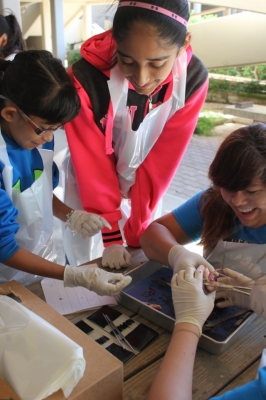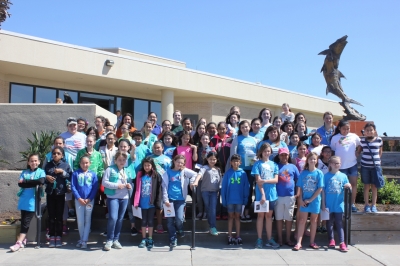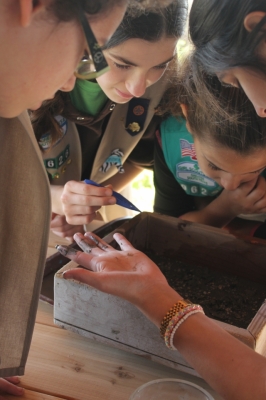 Girls practice fish dissections and learn what makes fish tick. Credit (University of Texas Marine Science Institute, Tiffany Moreno).The University of Texas Marine Science Institute (UTMSI) and Mission-Aransas Reserve held its second annual Women in Marine Science Day this past Saturday. Over 50 girls from throughout the Coastal Bend attended. The purpose of the event was to introduce girls in the 5-8th grade to marine science. The day featured hands-on activities taught by the women researchers and educators at the University of Texas Marine Science Institute. Girls had a chance to get their hands dirty searching through the mud from local bay waters and find worms, brittle stars, and more. They were also able to try their hand at laboratory experiments, such as those that use light to change the behavior of plankton. These are just a few examples of the activities that the girls participated in. This event sparked enthusiasm for marine science and taught how science can be fun, enlightening and maybe even a little messy. Here are just of few of the sentiments from the day:
Girls practice fish dissections and learn what makes fish tick. Credit (University of Texas Marine Science Institute, Tiffany Moreno).The University of Texas Marine Science Institute (UTMSI) and Mission-Aransas Reserve held its second annual Women in Marine Science Day this past Saturday. Over 50 girls from throughout the Coastal Bend attended. The purpose of the event was to introduce girls in the 5-8th grade to marine science. The day featured hands-on activities taught by the women researchers and educators at the University of Texas Marine Science Institute. Girls had a chance to get their hands dirty searching through the mud from local bay waters and find worms, brittle stars, and more. They were also able to try their hand at laboratory experiments, such as those that use light to change the behavior of plankton. These are just a few examples of the activities that the girls participated in. This event sparked enthusiasm for marine science and taught how science can be fun, enlightening and maybe even a little messy. Here are just of few of the sentiments from the day:
“My favorite activity was Ocean Space Race. It taught me something I didn’t know but now I will remember forever” – Madison Pimentel
“This was very fun so I would come again” – Alayna Osborne
“My favorite activity was the fish dissection because it was hands on and fun.” – Claire O’Brien
“Great program would definitely come back” – Parent
“Please keep this event going – very empowering for our girls. “ – Parent
“I was happy my daughter had this opportunity. Teachers were very knowledgeable. Thank you for this opportunity.” – Troop leader
 Over 50 girls from throughout the Coastal Bend participated in this years’ Women in Marine Science Day. Credit (University of Texas Marine Science Institute, Tiffany Moreno).
Over 50 girls from throughout the Coastal Bend participated in this years’ Women in Marine Science Day. Credit (University of Texas Marine Science Institute, Tiffany Moreno).
 Girls discover that mud can contain a life of its own and is full of invertebrates like brittle stars, worms and clams. Credit (University of Texas Marine Science Institute, Tiffany Moreno).
Girls discover that mud can contain a life of its own and is full of invertebrates like brittle stars, worms and clams. Credit (University of Texas Marine Science Institute, Tiffany Moreno).